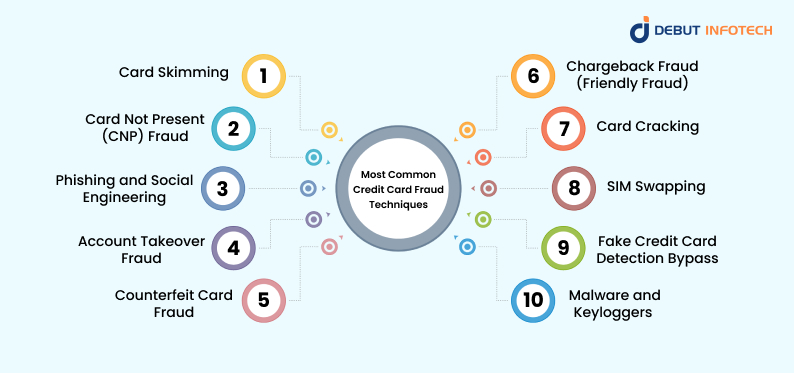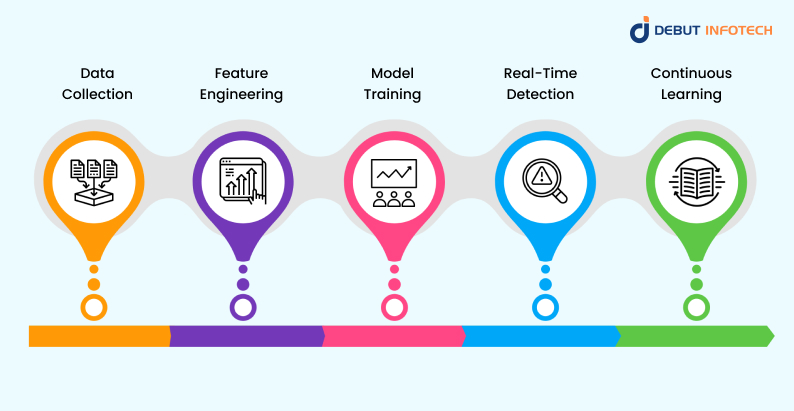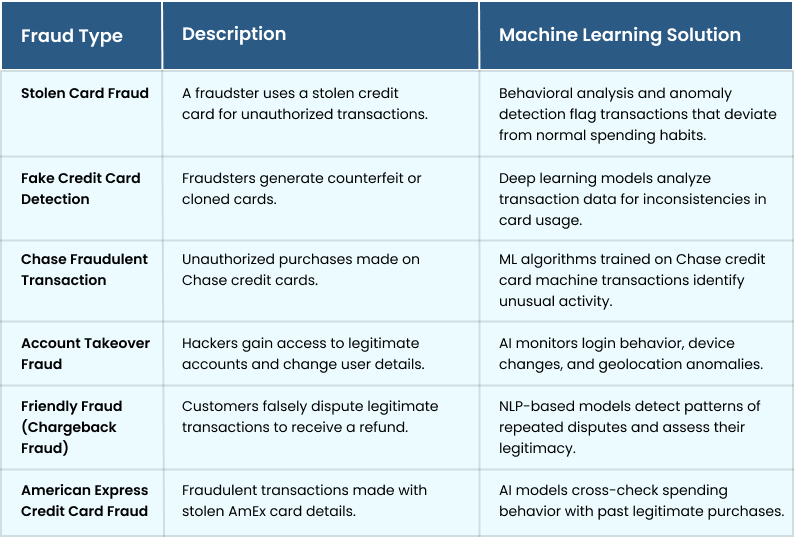Table of Contents
Home / Blog / AI/ML
Card Fraud Detection: ML-Driven Security Against Modern Fraud Tactics
February 26, 2025

February 26, 2025
As digital payment methods become more widespread, the amount of fraudulent transactions that can occur continues to increase. Criminals are getting better and better at finding ways to circumvent security measures, whether it’s through the use of stolen credit card information or making illicit purchases. For banks, financial institutions, and payment service providers, card fraud detection now ranks a major issue. In many cases, the ever-changing nature of fraud techniques is too much for traditional fraud detection systems to handle. This is where ML comes in; it provides a sophisticated method to adjust to new dangers and detect fraudulent actions more accurately.
With credit card fraud detection using machine learning, organizations can analyze vast amounts of transaction data in real-time, detecting suspicious behavior before damage occurs. Using data on past fraud incidents, machine learning models can spot outliers and alert authorities to possible fraud efforts with high accuracy. Using AI to identify fraudulent transactions is revolutionizing financial security. This includes detecting unlawful purchases on American Express credit cards, blocking Chase fraudulent transactions, and boosting PayPal credit card testing. This paper explores the inner workings of ML-based fraud detection, highlights essential ML methodologies, and covers the most recent trends in the sector.
Strengthen Your Fraud Detection with AI-Powered Solutions
Protect your business from financial transaction fraud with advanced AI and machine learning models. Partner with experts to implement cutting-edge fraud detection strategies.
How Machine Learning Enhances Credit Card Fraud Detection
1. The Limitations of Traditional Fraud Detection Methods
Traditional methods of detecting fraudulent activity depend on set criteria, such as identifying purchases beyond a particular threshold or prohibiting payments from certain high-risk regions. These methods work pretty well, but they have trouble with:
- High rates of false positives: Customers are irritated because legitimate transactions are frequently mistaken for fraudulent ones.
- Slow adaptability: Fraudsters rapidly find ways to get around strict policies.
- Lack of real-time processing: Many rule-based systems analyze transactions post-factum, allowing fraudulent charges to go undetected.
Machine learning gets beyond these constraints by learning from new fraud patterns and providing more dynamic and accurate detection.
2. Machine Learning for Anomaly Detection in Transactions
Unusual spending habits are a common indicator of fraudulent activities. It is easier to spot fraudulent transactions with the help of machine learning for anomaly detection, which can spot user behavior that deviates from the usual. Important methodologies include:
- Supervised learning: ML models are trained on labeled datasets containing fraudulent and legitimate transactions, learning to distinguish between them.
- Unsupervised learning: The model analyzes transaction patterns and flags unusual activities without predefined labels, which is useful for detecting new fraud tactics.
- Semi-supervised learning: Combines both approaches for more effective fraud detection.
Banks and payment issuers can reduce false alarms and raise fraud detection rates by including these models in financial security systems.
The Most Common Credit Card Fraud Techniques
With hackers using several strategies to exploit weaknesses in financial systems, credit card fraud has evolved and grown more complex. Knowing these typical fraud methods will enable companies and people to prevent financial losses by taking proactive measures.

1. Card Skimming
Using a simple gadget, card skimming is the theft of credit card information from a card swiped at an ATM or payment processing station. The stolen data is used to make fake cards or buy things online without permission.
2. Card Not Present (CNP) Fraud
CNP fraud is the exploitation of stolen card information by fraudsters for internet or phone transactions devoid of actual card access. For e-commerce companies, this kind of fraud is a huge obstacle since it is impossible to personally confirm the cardholder’s identity.
3. Phishing and Social Engineering
Criminals use fake emails, text messages, or phone calls to get people to give them their credit card information. The senders of these messages pose as trusted financial organizations, such as American Express or Chase, and request that the recipient confirm or update their payment information.
4. Account Takeover Fraud
Cybercriminals steal login credentials and access the victim’s credit card or online banking accounts. Once they have control, they can make illegal purchases, modify account settings, or request new credit cards.
5. Counterfeit Card Fraud
Criminals can use stolen card information to make fake credit cards with the help of modern printing and data encoding technologies. Many people use these fake cards to make transactions at stores that don’t have EMV (chip-based) protection.
6. Chargeback Fraud (Friendly Fraud)
A few dishonest people take advantage of the chargeback system by completing a legal purchase and then denying involvement in the transaction. They keep the bought products or services while asking the card issuer for a refund.
7. Card Cracking (How to Card Crack Techniques)
Criminals use stolen card details to make small test transactions before larger fraudulent purchases. If the initial transaction goes unnoticed, they withdraw large amounts of money or make expensive purchases.
8. SIM Swapping
An individual commits this form of fraud when they deceive a cell carrier into porting a victim’s phone number to an alternative SIM card. Hackers can get around two-factor authentication (2FA) and get into bank accounts, credit card portals, and other private financial data once they have the victim’s phone number.
9. Fake Credit Card Detection Bypass
Some fraudsters manipulate security checks on payment platforms to bypass fake credit card detection systems. They use stolen or synthetic card details to pass fraud filters, making it harder for businesses to detect unauthorized transactions.
10. Malware and Keyloggers
Cybercriminals use malicious software to capture sensitive data when users type their credit card details into a website. Keyloggers record every keystroke, allowing attackers to steal card numbers, CVV codes, and passwords without the victim’s knowledge.
Machine Learning Algorithms for Fraud Detection
Several ML algorithms have special benefits and propel fraud detection techniques.
Machine Learning Techniques Used in Fraud Detection
1. Decision Trees and Random Forests
Decision trees sort financial transactions according to a number of criteria, including the amount, location, and device used. An assembly of decision trees, called random forests lowers overfitting and increases fraud detection accuracy.
2. Neural Networks and Deep Learning
By learning human decision-making, neural networks analyze complex fraud trends. Finding connections between events in a series is made easier by Convolutional Neural Networks (CNNs) and Recurrent Neural Networks (RNNs).
3. Logistic Regression and Gradient Boosting
These ML models assign probabilities to transactions, helping detect fraud based on historical fraud trends.
4. AI Integration for Real-Time Fraud Detection
With the help of cutting-edge AI integration, financial institutions can now handle and evaluate transactions instantly. When combined with a counterfeit money detector system, AI-powered fraud detection improves general financial security.
Related Read: What are Machine Learning Techniques?
Key Steps in ML-Based Card Fraud Detection:

- Data Collection – Gathering transaction history, user behavior data, and known fraud cases.
- Feature Engineering – Extracting relevant attributes like transaction amount, merchant category, and location.
- Model Training – Using algorithms such as decision trees, neural networks, and support vector machines to classify fraudulent and legitimate transactions.
- Real-Time Detection – Deploying trained models in live payment systems to flag suspicious transactions.
- Continuous Learning – Updating models with new fraud patterns to maintain accuracy.
ML-based fraud detection offers a higher recall precision accuracy than traditional rule-based systems, minimizing false positives while effectively blocking fraudulent transactions.
Types of Credit Card Fraud and Machine Learning Solutions
There are several ways that fraudulent credit card transactions could occur, each needing specific detection systems. Common fraud forms are listed here, together with how machine learning development services address them:

These tools assist businesses like American Express to protect consumer accounts and improve Chase fraudulent transaction detection.
Real-World Applications of AI in Fraud Prevention
1. How Banks Use Machine Learning to Detect Fraud
Banks such as Chase credit card machine networks and American Express credit card fraud teams use ML to analyze millions of daily transactions and quickly detect problematic behavior. With high accuracy, AI models can identify fraudulent wire transfers, account takeovers, and card skimming.
2. E-commerce and Digital Payment Security
Platforms like PayPal deal with constant fraud issues, including the PayPal app security challenge not working, which lets fraudsters take advantage of security flaws. PayPal credit card testing is improved by AI-driven fraud detection, stopping illegal transactions.
3. Retail and Fake Credit Card Detection
Retailers depend on AI-powered fake credit card detection systems to avoid fraudulent transactions. ML models examine card data, spot fake cards, and notify businesses of possible fraud threats.
4. Financial Transaction Card Fraud Prevention
By evaluating buying patterns and preventing dubious transactions before they are handled, artificial intelligence-powered fraud detection shields companies from financial transaction card fraud.
Challenges in Implementing AI for Card Fraud Detection
1. Unexpected Custom Data from the Client
One difficulty in detecting fraud is handling unanticipated client-side bespoke data, which can lead to performance discrepancies in ML models. Maintaining accuracy depends on ongoing model training.
2. Keeping Up with Machine Learning Trends
Banks and other financial organizations must keep up with the latest advancements in machine learning because fraud strategies change fast. Machine learning models must regularly be retrained utilizing the most recent fraud datasets.
3. Data Privacy and Security
Protecting customer data while implementing AI-driven fraud detection is a major concern. Organizations must comply with strict data security regulations while using ML for fraud prevention.
Machine learning consulting firms refine fraud detection models to overcome these issues, ensuring optimal recall, precision, and accuracy.
Integrating AI into fraud detection systems involves development, deployment, and maintenance costs. Web application development costs related to fraud detection solutions vary by company and complexity.
The Future of AI in Credit Card Fraud Detection
As fraud tactics become more sophisticated, AI and machine learning continue to evolve, offering advanced solutions to detect and prevent financial transaction fraud. Here are key areas shaping the future of AI-driven fraud detection:
- AI vs Machine Learning: Which is More Effective?
The ongoing debate between AI and machine learning in fraud detection highlights their strengths. While machine learning models excel at pattern recognition, AI-powered systems go further by incorporating Natural Language Processing (NLP) and advanced AI algorithms. This enhances real-time decision-making and allows fraud detection systems to adapt dynamically to new threats. - Advancements in AI Tech Stack for Fraud Prevention
Modern artificial intelligence (AI) advancements are constantly being incorporated into the fraud protection tech stack. This includes state-of-the-art technologies such as decentralized AI networks, privacy-preserving federated learning, and blockchain for safe transactions. Collectively, these developments enhance the precision and effectiveness of systems that detect fraudulent activity. - Role of Machine Learning Development Companies in Fraud Detection
Leading machine learning development companies play a critical role in advancing fraud detection solutions. These firms develop tailored AI models for financial institutions, fintech startups, and e-commerce businesses, enabling more ml precise fraud identification and mitigation strategies. - Machine Learning Consulting Firms for Fraud Prevention
Businesses looking to strengthen their fraud detection capabilities can collaborate with machine learning consulting firms. These firms provide expert guidance on AI implementation, risk assessment, and deploying customized fraud prevention strategies, ensuring a proactive approach to combating financial fraud.
Need Custom Fraud Detection Solutions?
We design AI solutions that align with your business goals whatever they may be. Whether you want to improve safety or supercharge productivity, our custom solutions are your best bet.
Conclusion
As digital transactions grow, card fraud detection has become a top concern for financial institutions, e-commerce platforms, and payment service providers. Outperforming conventional rule-based systems, credit card fraud detection using machine learning presents a potent and dynamic method of combating fraud. Through real-time monitoring to prevent fraudulent transactions before they inflict damage, AI-driven fraud detection reduces false positives and enhances accuracy.
As fraud techniques change, Businesses must embrace AI-powered security measures to protect financial transactions. Machine learning is transforming fraud prevention from identifying Chase fraudulent transactions to securing PayPal credit card testing and enhancing false credit card detection. Businesses can use artificial intelligence to keep ahead of cybercriminals and safeguard their financial assets by working with seasoned machine learning development companies such as Debut Infotech.
Frequently Asked Questions
A. Credit card fraud detection using machine learning involves algorithms to analyze transaction data and identify patterns indicative of fraudulent activity. These models learn from historical data to detect anomalies and predict potential fraud in real-time.
A. Machine learning enhances fraud detection accuracy by continuously learning from vast datasets, identifying subtle patterns, and adapting to new fraudulent behaviors. Techniques like anomaly detection and ensemble learning contribute to more precise identification of fraudulent transactions.
A. Challenges include handling imbalanced datasets, as fraudulent transactions are rare compared to legitimate ones, ensuring data privacy, and maintaining model performance over time as fraud tactics evolve.
A. Common algorithms include Decision Trees, Random Forests, Support Vector Machines (SVM), and Neural Networks. Ensemble methods and hybrid models are also employed to improve detection rates.
A. Techniques such as Synthetic Minority Over-sampling Technique (SMOTE), under-sampling, and cost-sensitive learning address class imbalance, ensuring the model accurately detects fraud despite the disparity in class distribution.
A. Feature selection involves identifying the most relevant variables that contribute to distinguishing between fraudulent and legitimate transactions, thereby improving model performance and reducing computational complexity.
A. Businesses can integrate these systems by collaborating with machine learning consulting firms or development companies to develop tailored solutions. This involves data integration, model deployment, and continuous monitoring to adapt to emerging fraud patterns.
Talk With Our Expert
Our Latest Insights
USA
2102 Linden LN, Palatine, IL 60067
+1-703-537-5009
[email protected]
UK
Debut Infotech Pvt Ltd
7 Pound Close, Yarnton, Oxfordshire, OX51QG
+44-770-304-0079
[email protected]
Canada
Debut Infotech Pvt Ltd
326 Parkvale Drive, Kitchener, ON N2R1Y7
+1-703-537-5009
[email protected]
INDIA
Debut Infotech Pvt Ltd
C-204, Ground floor, Industrial Area Phase 8B, Mohali, PB 160055
9888402396
[email protected]




Leave a Comment